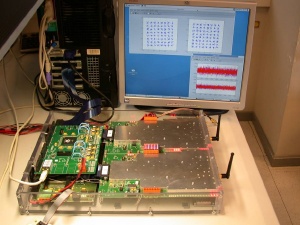IMEC, a world-leading independent research center in nanoelectronics and nanotechnology, has demonstrated spectrum sensing functions, using an experimental setup including its integrated reconfigurable radio platform. The setup senses information on spectrum occupancy from UMTS and WLAN signals in specific bands. It retrieves information on the frequency and bandwidth, with estimates for power and noise. The system includes IMEC’s advanced ASICs implementing a programmable baseband platform and a flexible RF transceiver front-end. This transceiver offers the possibility to scan from 100 MHz to 6GHz.

IMEC’s achievement comes in time to profit from the recent worldwide switch from analogue to digital terrestrial TV. This switch frees a large portion of valuable spectrum, and is therefore often named the digital dividend. Opportunistic wireless devices will be able to operate in these white spaces, the former TV broadcast channels. Such TV Band Devices (TVBD) will include the ability to detect the primary users of frequency bands, thus allowing the secondary use of the band without interfering with the primary users.
A key driver for the future success of small and portable TVBDs will be an efficient and low-power sensing technology. IMEC is now working to further develop a flexible, cost-friendly, and energy-efficient engine for spectrum sensing.
IMEC is a world-leading independent research center in nanoelectronics and nanotechnology. IMEC vzw is headquartered in Leuven, Belgium, has a sister company in the Netherlands, IMEC-NL, offices in the US, China and Taiwan, and representatives in Japan. Its staff of more than 1650 people includes about 550 industrial residents and guest researchers. In 2008, its revenue (P&L) was EUR 270 million.
IMEC’s More Moore research aims at semiconductor scaling towards sub-32nm nodes. With its More than Moore research, IMEC looks into technologies for nomadic embedded systems, wireless autonomous transducer solutions, biomedical electronics, photovoltaics, organic electronics and GaN power electronics.
IMEC’s research bridges the gap between fundamental research at universities and technology development in industry. Its unique balance of processing and system know-how, intellectual property portfolio, state-of-the-art infrastructure and its strong network worldwide position IMEC as a key partner for shaping technologies for future systems.